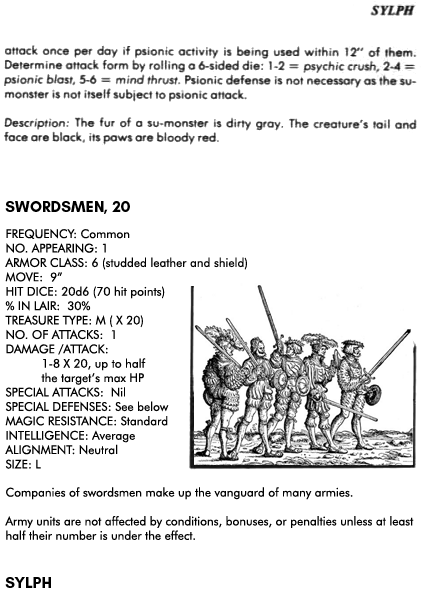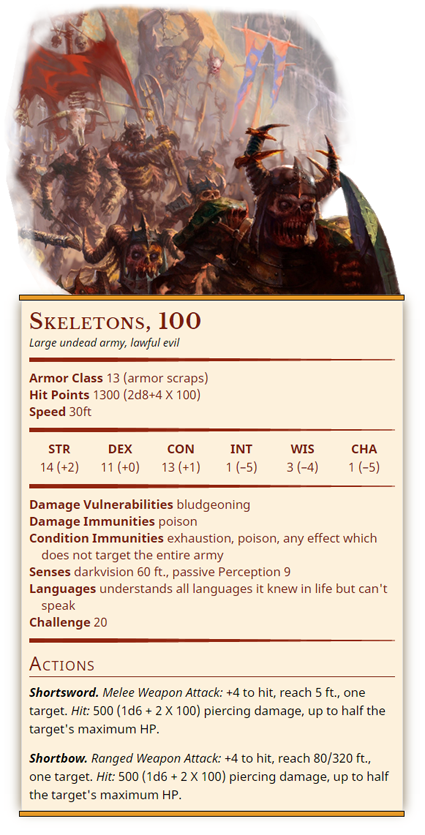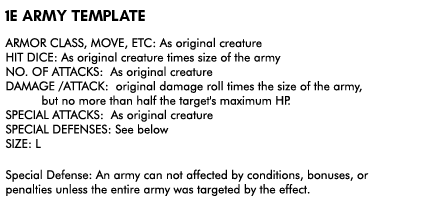D&D started as a hack on a war game, which is why OD&D depends on, but does not provide, mass combat rules. The original game included kingdom management rules and prices for castles and armies. The first adventure module, in the Blackmoor supplement, had rooms that contained hundreds of soldiers. You were expected to break out TSR’s Chainmail war game to use these things. In fact, as you got higher and higher level, Gygax expected that more and more of your time playing D&D would actually be spent playing Chainmail. That’s sort of like if you went to a Scrabble tournament and they said, “Good news! You guys are such good Scrabble players that now you get to play Monopoly.”
D&D went mainstream because audiences liked the fast, immersive, co-op game of the imagination, and they didn’t latch onto (or even understand the references to) the slow, rules-bound, head-to-head, miniature-requiring war game. So, in later editions, the Chainmail references were cut. Essentially, D&D’s intended end game, conquest and rulership, was removed. The middle of the game, grinding for money, was extended, even though there were now no castles and armies to spend the money on.
And this is a big loss for D&D. In any edition, high level D&D is not a solid product. High level fights are swingy, monster variety is sparse. And, worse, with epic battles and kingdom-building mostly offscreen, characters can’t leave their mark on the game world, except by saving it from ever more powerful dungeon monsters. Players and DMs alike generally try to keep away from war epics, because running big battles isn’t something D&D does.
To fill the hole left by the removal of Chainmail and epic-fantasy play, TSR and WOTC churned out stand-alone battle supplements every few years:
-OD&D introduced Swords & Spells, which was an updated Chainmail with special rules for each of the D&D spells and monsters. It technically allowed battling lone heroes against 10:1 (10 soldiers to a mini) figures, although it recommended avoiding cross-scale combat as much as possible.
-Basic D&D included War Machine: a sort of spreadsheet where you came up with a rating of each army and then rolled a percentile die to decide the battle.
-1e and 2e both published an edition of Battle System. This was another entry in the Chainmail/Swords & Spells tradition, but it came in a box with cut-out-and-assemble peasant houses, which was cool.
-3e had the Miniatures Handbook. Again, its mass combat rules were along the lines of Chainmail, featuring typical war game rules for formations, facing, morale, etc, using d20 mechanics.
-5e has two sets of playtest mass-combat rules, some iteration of which will presumably see official publication some day. The first playtest has traditional wargame-style rules, with frontage, etc. The second boils down every army to a single “battle rating”, in the Basic War Machine tradition.
All of these games perpetuate the flaw that kept Chainmail from catching on in the first place: in order to play them, you have to stop playing D&D.
D&D is not a war game. All the design decisions that make a good war game lead to a bad D&D game, and vice versa.
-Because war games are played competitively, they must be fair. D&D campaigns can only achieve longevity when they are unfair in favor of the players.
-Because war games are fair: war games must have complete rules. You can’t make stuff up halfway through without favoring one of the players. So you can only make a pontoon bridge if there are rules for it. D&D rules are incomplete by design. There are no rules in any edition for making a pontoon bridge, but if you can scrounge up some boats and lumber, the DM will let you do it.
-Because war games are complete: war games must have detailed rules. A good war game models the rock-paper-scissors of archery, cavalry, and spearmen, and provides big bonuses and penalties based on terrain, flanking, morale, fog of war, high ground, and anything else that might conceivably come up. D&D, on the other hand, features abstract combat rules that look nothing like reality. Core D&D combat is a barebones transaction of combatants trading swipes. More important than realism is simplicity, because most of D&D is not in the combat engine but in the DM and player improvisation that happens at the same time.
running an epic battle in D&D
D&D is great at handling small fights – say, five characters fighting a few trolls. Why can’t the same rules handle five characters, the town guard, and a dragon fighting against a skeleton army, a lich, and a dozen trolls?
What if the first edition Monster Manual had contained stat blocks for a skeleton horde, a town watch, and so on? Think of the stories we could have been telling all these years.
My alternate-history army stat blocks are pretty simplistic, but that’s what I like about them. A requirement for war-game standards of rules completeness and detail has been holding back high-level play for years. A D&D combat is great because of all the rules that Gary Gygax didn’t include. Let me talk about the war game rules I think D&D can live without.
Casualties. When half your archers are dead, you can fire half as many arrows, right? Nah. Just as a D&D hero at 1 hp fights at full strength, A 100-soldier army, even at 1 hp, is still a 100-soldier army. After the battle, hit point damage can be translated into some ratio of dead, wounded, and fled, at the DM’s discretion.
Facing, frontage, formation. These rules appear in nearly every war game. We need that level of detail like we need the First Edition grapple rules.
Figure scale. War games are not designed for varying figure scales: every miniature on the battlefield needs to represent, for instance, 20 soldiers. A war-game fight between a lone hero and a 20:1 army unit is usually wonky or impossible. On the other hand, if every army is treated as an individual D&D monster, a tenth-level fighter can battle on fairly even terms with a troop representing 10 first level fighters, which can in turn battle a troll or a unit of 36 goblins.
Time scale. Most war games have realistic but D&D- incompatible turns of ten minutes or more. I’m sticking with D&D combat rounds. If a massive war is over within a few six- second rounds, that’s fine with me.
If anything, D&D-style fights can be too fast. To make it more likely that everyone gets a turn, I’ve added a special rule in my army stat blocks, capping attack damage so that no army can score a one-hit KO. This favors the underdog (and the underdog is usually the PCs). Still, this is a special exception and I wouldn’t be surprised if it were unnecessary.
Leadership bonuses. Many war games assign static bonuses to troops based on the abilities of their commanders. In a war game, which doesn’t allow for referee discretion, this is the best you can do. But in D&D, if a player delivers a speech and leads a charge, or comes up with a clever scheme, the DM can assign appropriate bonuses. The more the players act creatively, the more vivid the scene will be – just as in a standard D&D fight.
Spell rules. We do NOT want a Swords and Spells-style gloss on every spell describing its interaction with armies. Here are my abstractions:
1) Damage spells ignore area of effect. An 8d6 fireball does 8d6 damage.
2) “Condition” spells are all-or-nothing. If a Bless spell can target all the members of an army, it operates normally. Otherwise, it fails.
Morale, flanking, setting ambushes, charging, fighting withdrawal, high ground, and every special case I haven’t already mentioned. First and and Second Edition have explicit morale rules. In other editions, morale failure is by DM fiat. If the local morale rules (or lack thereof) are good enough for 10 goblins at level 1, they’re good enough for 100 goblins at level 10. The same principle, “use existing combat rules”, applies for flanking (present in 3e and 4e), charging (present in every edition but 5e) and so on.
Here are the stat-block templates I’ve used for turning any creature into an army of any size. I’ve done first and fifth editions (my current favorites).












I really like your simple approach. These days I’m much more likely to try it your way, than to bust out my copy of Battle System!
So I think I understand this correctly.
A Lone hero can go up against a 100 skeleton army, and as long as he isn’t hit twice, he has a chance of mowing through all of them. If he gets hit, each of those 500 pt hits gets reduced to 1/2 his HP, so it just takes the two hits to take him out.
The spells doing the same damage vs 20 Swordsmen in a horde vs 20 individual menat arms really changes the impact of damge dealing spells with an area of effect. 20 1HD foes facing an 8d6 fireball are serously threatened where as they can mostly ignore that fireball if they are treated as one monster with 20HD.
Godbound kinda does already with Mobs. The rulebook’s free on DriveThru, the relevant section is on page 152.
Damn. I love this. One thing I’d probably change is the damage output of those critters though. You’d never fight 100 skeletons all at the same time. Even 100 skeletons vs 100 skeletons wouldn’t fight each other all at one time. There’s a type of “frontage”, which I agree is unnecessary in simulating here, could nonetheless be reflected in the unit’s damage output.
Instead of 100 skeletons, think of it as a block of 10×10 skeletons. Then the damage output goes down from 500 on a hit to 50. Much more reasonable, methinks. Same with the fighters. Instead of 1d8x20, why not have it 1d8x5?
You could also introduce some sort of “on a miss you still take x damage” mechanic, because let’s face it, that number of people aren’t all going to miss.
Man, now you’ve gone and got me thinking. And here I was just contemplating introducing domain-level play in my current campaign.
I was thinking the same thing about facing etc. I think it could scale as much as you want with the power of… MATH!
If you didn’t mind a little natural logarithms, you could do damage as:
Damage * n/[ln(n)+1]
Which then scales the effective length of the combat by 1 (for 1 in the “army”) up to around 16.4 times for an army of 5 million. That number will also drop by quite a bit (probably by roughly 1/3) if you include a “half damage for misses” rule, which makes quite a bit of sense.
Also, if you wanted the battle to go faster, you could use base 10 log (7.7 times for 5 million as opposed to the 16.4 above).
I’ve got to try this out!
Also I think that it should be stated that there is no initiative, so armies damage each other simultaneously. This matters only when an army would be wiped out. This shouldn’t be too much of a problem as many morale rules have armies routing when they get down to 1/2 strength or less.
As to spells, I think the scaling is still OK, since the 8d6 fireball isn’t going to hit every one of the men-at-arms.
Actually the DMG 5e (page 250) has rules for mass combat and although the mob rules are intendet against single targets they work against bigger groups just as well.
So for example if 100 skeletons attacked 20 swordsmen (AC14, 10hp each), 80 skeletons would defeat those poor swordsmen while 20 more could rush ahead or shoot at some other target. This asumes that both parties were formationed in a battle line but the DM could easily decide that only the frontline can fight because eg. of a narrow pass. Also those swordsmen could have taken the doge action previously and thus held their ground with 8 men standing one of them wounded.
Garnish this all with moral rules (page 273) and Loyalty rules (page 93) for mercenaries or maybe also the optional rules for flanking and facing (page 251+252) to create epic battles.
I’m not sure how I feel about this mass combat system.
…oh sure, its amazingly simple, but I liked your old one (with the three attacks) that I made an entire wargaming system out of it. Or at least, I made one for simple mercenary armies of the Big Five Player character races (half-breeds and drow are hard to judge. Also, Half-Orcs’ ability to withstand fatal blows screws with the system hard)
It was a surprising amount of work to change the stats from guard wearing chainmail (monster manual norm) to guard wearing scale or whatever while using THIS weapon…to creating a thug version for that. Originally used Thug, Guard, and Scout stats to create a balanced mix (Bandits and Tribal Warriors share the same CR with guards but have a weakness in strength or dexterity, respectively. Who knew?) Anyway, this whole thing started as a passing thought and its just been sitting on my computer since then.
I didn’t have any plans for it, but I suppose I could send you a copy of the document I have. With your permission, I could also create a google doc and link it here….for all three of the people who might scroll down here and read it one day…
er…. in that this article’s already a little old and everybody moved on to other things, not that your blog is unpopular.
Also, your system is pretty great at needing practically no bookkeeping. Its probably way superior to mine/your old one. I just sort of think my system better simulates cavalry charges and how armies fight each other. I think that your new system has way better rules for resolving spell effects, however.
I have to wonder, given the needs for complete and equivalent rules, if a good 5e mass battle system could be built out of 4e. For example, the minion rules remind me of the one-hit-one-kill rules of Chainmail, and rules for marking and pushing scale well to units fighting each other (as well as having different fixed defenses to manage attacks on such combined bodies).
I find the 1E grapple rules so vital I use them everywhere: 2E, 3E, Traveller, Monopoly, Yahtzee.
I like the simplicity of this. It’s very similar to a system I proposed:
http://www.enworld.org/forum/showthread.php?525972-Unearthed-Arcana-Mass-Combat/page5&p=7033154&viewfull=1#post7033154
The main differences are that I assumed you would need to update the size of the group (by dividing remaining HP) and adjust the damage multiplier accordingly, and you would need to multiply the damage of area effects based on the number of affected creatures.
Damn. I’m sorry, Paul, but when it comes to wargames, you are almost completely mistaken.
Have you ever READ Chainmail?
Take a look at the Columbia wooden block board games. I own “Liberty: Am. Revolution” It uses square wooden blocks painted Red for british and blue for Colony forces. On the player side it has a sticker that shows unit type and strength. It’s like the game Stratego but with 4 sides to each piece. So George Washingtons army is strength A and hp 4 while a group of NY militia is strength C and hp 2. Cavalry can move 2, foot 1. A’s go first and roll dice = to current hp (4). So 4d6 with a hit on 4 or less.
If they take a hit in combat, they become 3 then 2 then 1 then captured. You rotate the piece so the 4,3,2,1 is at the top. There are special rules for bayonette charge and naval bombardment.
During movement/resupply you can’t see the type of unit in boston and virginia that the opponent has, but when two armies meet the pieces are revealed for combat. I’ve always thought it would make an elegant system to use in DnD mass combat. Put a map of the western elven forest on the table, drop 10 dice for the elven armies at the main city and 2 cities to the north and south. Place a few enemy dice where scouts have reported sightings. Let the pc’s choose to scout the unknown areas or help fortify the main line.
Color-coded d6 dice could be used the same way. Red = power A, Yellow B, Green C, Blue D. Flip the number for current active troops 6—1.
20 elite cavalry level B hp 2 (roll 2d6, hit on 3 or less)
30 regular cavalry level C hp 3 (roll 3d6, hit on 2 or less)
2 blocks of 20 pikemen level C hp 2 each
40 goblins level D hp 4 (4d6, only hit on a 1)
20 orcs level C hp 2
10 ogres level B hp 2 (to show extra hp for large ogre)
Just put a small 1″ piece of paper under each die to show the troop type and hope the cat doesn’t decide to jump on the table!
I absolutely love this idea. Most of the rules I’ve found for mass combat add a lot of extra bookkeeping, which I absolutely hate. In comparison, these rules are dead simple.
Great article. One point: od&d and ad&d 1e monster stats are already for mass combat. If you look at Orc, the no appearing is 30-300, and it lists information like for every N orcs, there is a sergeant, etc. For dungeon level encounters there is a separate table in DMG. For mass combat rules, od&d explicitly states Chainmail, and ad&d presupposes it. 30 miles per hex crawling is essentially for high level characters leading armies.